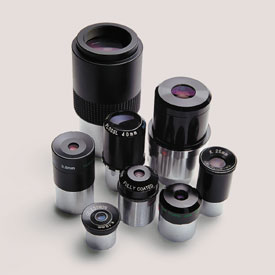
Optical aberrations, often mistakenly called distortions, limit the performance of an eyepiece.
Generally, the lower the f/number of the telescope, the greater the optical complexity of the eyepiece needed to produce good images. Simple two-element Huygens and Ramsden eyepieces with apparent fields of up to about 40° work quite nicely with high f/number telescopes, but a two-element design cannot be adequately corrected for fields greater than 40° or for low f/ratios.
You cannot judge an eyepiece by its name alone. Some orthoscopic eyepieces have a cemented triplet and a single eye lens, while others have two cemented doublets and might just as well be called Plössls. Even Plössls vary in design details from one to another. It is wise to check out an eyepiece before buying it, or at least seek the advice of others (perhaps astronomy club members) who have used them.
The following is a list of common problems with eyepieces, and some solutions to them.
Spherical aberration causes a softness of the image in the center of the field. It is not usually a problem with eyepieces that have three or more elements unless used with very fast objectives.
Axial color is the appearance of color fringes around an object at the center of the field. It is rarely a problem with designs using three or more elements, and it is absent from some two-element eyepieces.
Lateral color is seen as color fringes around objects near the edge of the field. This is difficult to "design out" of an eyepiece and can arise from poor manufacturing as well. This aberration may persist even when the eyepiece is used with objectives of high f/number.
Coma causes comet-shaped instead of round star images near the edge of the field. It is not usually encountered in good designs.
Astigmatism causes stars to appear as lines, crosses, or squares at the edge of the field. It is the most significant problem with wide-angle eyepieces, especially with low-f/number telescopes. Using a Barlow lens with the eyepiece will often suppress astigmatism dramatically.
Field curvature prevents an image from being in focus at the center and edge of the field simultaneously.
Distortion in an eyepiece makes straight objects look curved. While some eyepieces, especially orthoscopics, are better than others in this regard, distortion is not usually a problem in astronomical viewing.
Further Reading
How to Choose Your Telescope Magnification
Telescope Eyepiece Guide
 0
0









Comments
You must be logged in to post a comment.